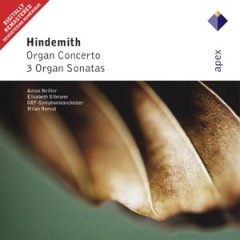Hindemith – Organ Works (1979)
Hindemith – Organ Works (1979)

Concerto For Organ And Orchestra 1 Crescendo - Moderato Assai 4:52 2 Allegro Assai 6:40 3 Canzonetta In Triads, And Two Ritornelli: Moderato 5:30 4 Phantasy On 'Veni Creator Spiritus': Allegro Moderato 11:37 Sonata I For Organ 5 Mäßig Schnell, Lebhaft 7:21 6 Sehr Langsam - Phantasie, Frei - Ruhig Bewegt 10:36 Sonata II For Organ 7 Lebhaft 4:27 8 Ruhig Bewegt 4:17 9 Fuge: Mäßig Bewegt, Heiter 3:03 Sonata III For Organ 10 Mäßig Bewegt 'Ach Gott, Wem Soll Ich's Klagen' 4:12 11 Sehr Langsam 'Wach Auf, Mein Hort' 3:58 12 Ruhig Bewegt 'So Wünsch Ich Ihr' Anton Heiller – organ (1-4) Elisabeth Ullmann – organ (5-12) ORF-Symphonieorchester Milan Horvat – conductor
Paul Hindemith (1895-1963) was one of Germany’s most important composers in the 1920s and 1930s. After the Second World War his fame declined. Hindemith’s œuvre is vast; his organ works represent only a small part of it. The Konzert für Orgel und Kammerorchester (Kammermusik No. 7 / Opus 46 No. 2, 1927) was written for the inauguration of the Weigle organ at the Frankfurter Rundfunk. Hindemiths remarks about this organ indicate that he fancied the ideas of the Orgelbewegung, but did not quite understand the details: ‘Ich bin kein Orgelfachmann.’ Since 1927 Hindemith tried to construct a theory on which to base his compositional technique. In 1937 he published this theory, entitled Unterweisung im Tonsatz. According to the Unterweisung, the triad is the beginning and the end of all music. Hindemith compares it with the three primary colours in painting and the three dimensions in architecture. In the same year, Hindemith published his first two organ sonatas as well. The first one is characterised by very precise indications with regard to articulation and phrasing; the second Sonata is less complicated and less representative for Hindemith’s style. The third Sonata was composed in 1940, after Hindemith had emigrated to the United States. It is based on three ancient German folk songs. Remarkable is the large number of crescendi- and decrescendi-indications, which require a register crescendo. The Concerto for Organ and Orchestra (1962/1963) is one of Hindemith’s last works. It was written for the inauguration of the organ at Lincoln Center, New York. Hindemith did not consider it one of his best compositions. Hindemith’s remarks about organs and the indications in his organ music are not coherent enough to enable us to draw conclusions about the ideal Hindemith organ. ---Peter Ouwerkerk, hetorgel.nl
download: uploaded anonfiles yandex 4shared solidfiles mediafire mega filecloudio nornar
Zmieniony (Środa, 08 Styczeń 2014 15:35)








